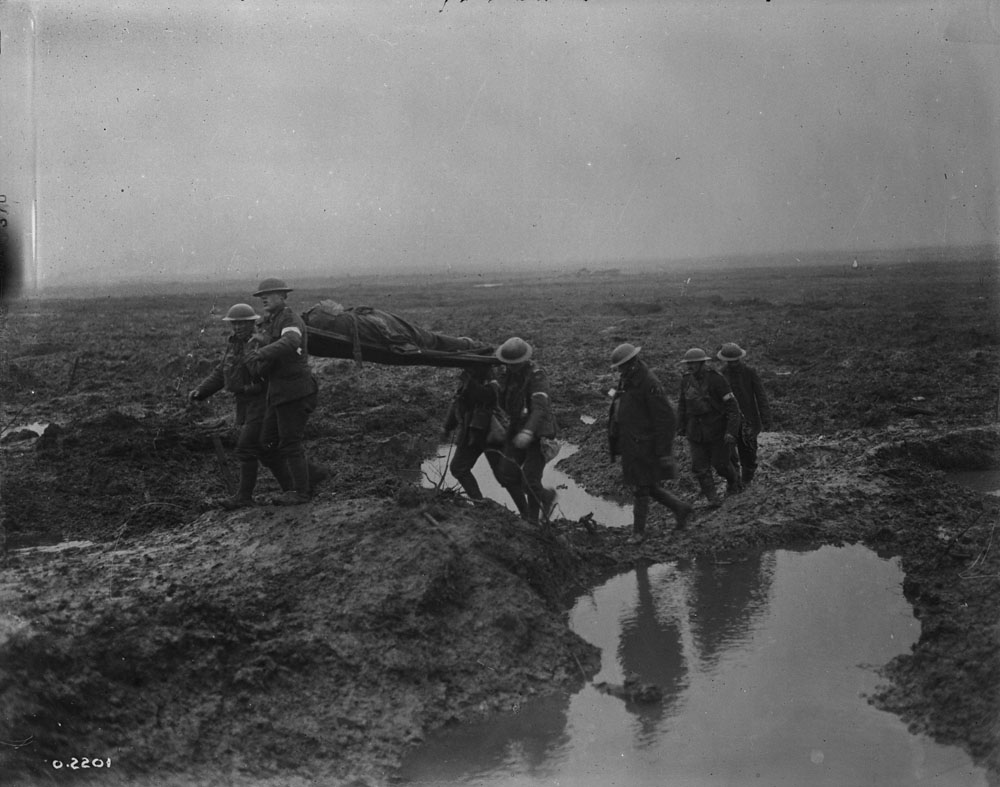Sergeant Frank Steel 530087 of No 8 Canadian Field Ambulance, CAMC, dressing wounds in the open, instantly killed by a shell during the Battle of Passchendaele. Initially buried at the foot of a large tree about 100 feet SSW of Waterloo Dressing Station.

Battle of Passchendaele
In Paul Nash’s painting, two soldiers try to follow the line of a road mutilated, almost beyond recognition. In fact, the whole landscape re-arranged, with the giant concrete blocks epitomizing this harsh new order. The bursts of sunlight have become gun barrels; the reflections of trees, steel structures. This was Paul Nash’s painting for the proposed Hall of Remembrance. The picture shows a tract of country near Gheluvelt village in the sinister district of Tower Hamlets, perhaps the most dreaded and disastrous locality of any area in any of the theatres of War.

Nash received the commission for this work, originally to have been called ‘A Flanders Battlefield’, from the Ministry of Information in April 1918. It was to feature in a Hall of Remembrance devoted to ‘fighting subjects, home subjects and the war at sea and in the air’. However, the Hall of Remembrance never built and the work given to the Imperial War Museum. Nash worked on the painting from June 1918 to February 1919.
Enlistment of Corporal Frank Steel
Frank Steel born 28 May 1873 in Cropwell Bishop, Nottinghamshire, England. NoK his sister Mrs Elizabeth Hodgson and nephew Frank Hodgson of Nottingham, England. A waiter by trade.
Corporal Frank Steel enlisted 16 July 1915 in Calgary, Alberta with the CAMC. Standing 5′ 2″ tall, 170 pounds, 42 years, 2 months of age, dark complexion, grey eyes and dark brown hair.
No. 8 Canadian Field Ambulance
Organized in Calgary in December 1915 under the command of Lieutenant-Colonel Samuel Williamson Hewetson. Left Halifax 1 April 1916 aboard SS ADRIATIC and arrived in England 9 April 1916 with a strength of 10 officers, 182 other ranks.

Sergeant Frank Steel
Corporal Frank Steel promoted to Acting Sergeant on 1 February 1916 at Bramshott Camp. Confirmed in the rank of Sergeant on 7 May 1916, the day prior to proceeding overseas.

France
No. 8 CFA arrived in France with the 3rd Canadian Division. Landed at Le Havre on 8 March 1916 and proceeded to the Embarkation Camp.
On 28 January 1917, commanding officer LCol Samuel Williamson Hewetson evacuated to England suffering from appendicitis. Hewetson died at 6 March 1917 at Royal Free Hospital.

LCol Ernest Raymond Selby eventually took command of No. 8 CFA.

Sergeant Frank Steel granted 10 days leave to England on 7 July 1917, returning to his unit on 19 July 1917.

No. 8 CFA arrive in the Ypres Salient on 15 October 1917. Move to the Main Dressing Station, Vlamertinghe Mill on 20 October 1917.
Vlamertinghe Mill ADS

Motor Ambulance Cars brought cases through the main entrance to the first door left of the entrance, where unloaded and taken into the room. This main room had good accommodation, well-heated, and used as a waiting room for cases prior to entering the Dressing Room.

The Dressing Room had 4 dressing tables, a Medical Officer and Dresser stationed at both. Shelves ran around the room containing dressing and other medical supplies. Beneath each stretcher table placed an oil-stove to provide warmth to the patients as attended to.

At the end of the Dressing Room stationed two clerks taking particulars on slips and handing them to each other who then made out the official medical card for attachment to each patient prior to removal.

The Outside Waiting Room loaded four cases at a time into Motor Ambulance Cars stationed at the outside door. Other large rooms reserved if necessary to accommodate patients should the Outside Waiting Room become too congested.
Waterloo Regimental Aid Post

At the Waterloo Regimental Aid Post, Sergeant Frank Steel killed in action 27 October 1917. Captain William Frederick Abbott of No. 9 CFA related the news of Steel’s death.

Waterloo Canadian Cemetery
Pte Steel exhumed from Waterloo Canadian Cemetery on 2 November 1920, Sheet 28.D.9.d.9.9 and buried in Plot XIV, Tyne Cot Cemetery.

Also known as Waterloo Farm Cemetery, Passchendaele, 650 metres North-East of ‘s Gravenstafel, containing the graves of ten soldiers from Canada, seven from the United Kingdom and two from New Zealand, who fell in 1917-18.

The pill box located here later destroyed following the Great War. Only a calvary exists at the location today.
Tyne Cot Cemetery

Plot XIV Casualties
Several of the men in Plot XIV, particularly those of the 58th Battalion, likely cared for by Sergeant Frank Steel on 26/27 October 1917 just prior to his death. Unknown if Private Joseph Bergeron the soldier Sgt Steel was attending to.
- Private Allister Lauder 838534 38th Battalion
- Sgt Arthur Minion Christian MM 406906 CMGC
- Pte Charles Reginald Dunlop 123734 2nd Battalion
- Pte Joseph Bergeron 754033 52nd Battalion, wounded and later killed by a shell while being carried out.
- Private Elmer McFalls 654816 “B” Coy, 58th Battalion
- Pte Frank Vernon 838667 58th Battalion
- Pte John Edward Carter 654662 58th Battalion
- Corporal John Foster 412068 58th Battalion
Contact CEFRG
More
- Home of CEFRG
- Blog
- CEFRG on FaceBook
- CEFRG on YouTube
- Soldiers and Nursing Sisters
- Units (Brigades, Battalions, Companies)
- War Diary of the 18th Battalion (Blog)
- 48th Highlanders of Canada
- 116th Battalion CEF – The Great War
- Les Soldats du Québec Morts en Service
- Montreal Aviation Museum
- Battles of the Great War
- Cases
- Cemeteries
- Memorials
- On This Day
- About CEFRG
